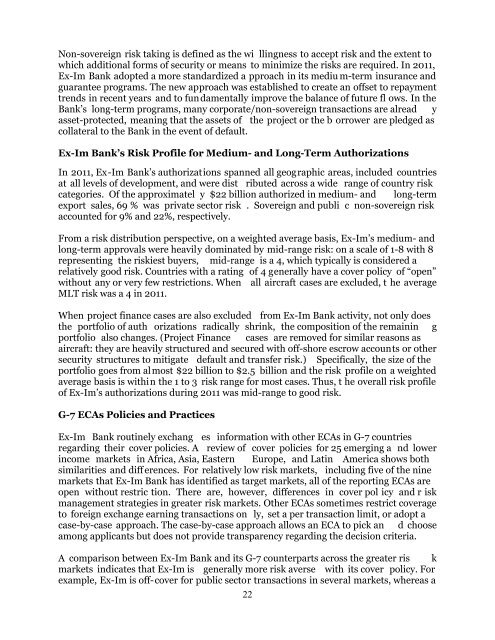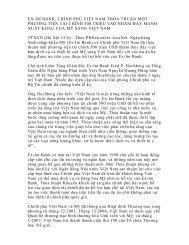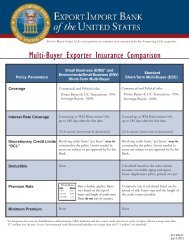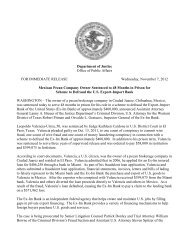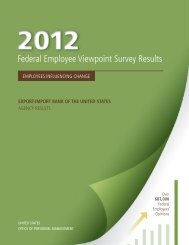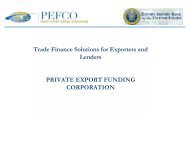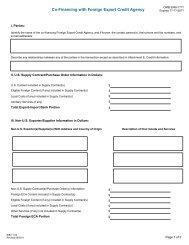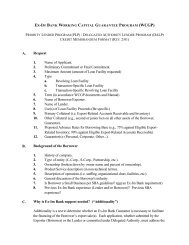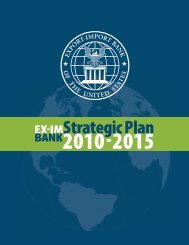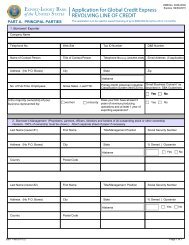2011 508 accessible version - Export-Import Bank of the United States
2011 508 accessible version - Export-Import Bank of the United States
2011 508 accessible version - Export-Import Bank of the United States
- No tags were found...
Create successful ePaper yourself
Turn your PDF publications into a flip-book with our unique Google optimized e-Paper software.
Non-sovereign risk taking is defined as <strong>the</strong> wi llingness to accept risk and <strong>the</strong> extent towhich additional forms <strong>of</strong> security or means to minimize <strong>the</strong> risks are required. In <strong>2011</strong>,Ex-Im <strong>Bank</strong> adopted a more standardized a pproach in its mediu m-term insurance andguarantee programs. The new approach was established to create an <strong>of</strong>fset to repaymenttrends in recent years and to fundamentally improve <strong>the</strong> balance <strong>of</strong> future fl ows. In <strong>the</strong><strong>Bank</strong>’s long-term programs, many corporate/non-sovereign transactions are alread yasset-protected, meaning that <strong>the</strong> assets <strong>of</strong> <strong>the</strong> project or <strong>the</strong> b orrower are pledged ascollateral to <strong>the</strong> <strong>Bank</strong> in <strong>the</strong> event <strong>of</strong> default.Ex-Im <strong>Bank</strong>’s Risk Pr<strong>of</strong>ile for Medium- and Long-Term AuthorizationsIn <strong>2011</strong>, Ex-Im <strong>Bank</strong>’s authorizations spanned all geographic areas, included countriesat all levels <strong>of</strong> development, and were dist ributed across a wide range <strong>of</strong> country riskcategories. Of <strong>the</strong> approximatel y $22 billion authorized in medium- and long-termexport sales, 69 % was private sector risk . Sovereign and publi c non-sovereign riskaccounted for 9% and 22%, respectively.From a risk distribution perspective, on a weighted average basis, Ex-Im’s medium- andlong-term approvals were heavily dominated by mid-range risk: on a scale <strong>of</strong> 1-8 with 8representing <strong>the</strong> riskiest buyers, mid-range is a 4, which typically is considered arelatively good risk. Countries with a rating <strong>of</strong> 4 generally have a cover policy <strong>of</strong> “open”without any or very few restrictions. When all aircraft cases are excluded, t he averageMLT risk was a 4 in <strong>2011</strong>.When project finance cases are also excluded from Ex-Im <strong>Bank</strong> activity, not only does<strong>the</strong> portfolio <strong>of</strong> auth orizations radically shrink, <strong>the</strong> composition <strong>of</strong> <strong>the</strong> remainin gportfolio also changes. (Project Finance cases are removed for similar reasons asaircraft: <strong>the</strong>y are heavily structured and secured with <strong>of</strong>f-shore escrow accounts or o<strong>the</strong>rsecurity structures to mitigate default and transfer risk.) Specifically, <strong>the</strong> size <strong>of</strong> <strong>the</strong>portfolio goes from almost $22 billion to $2.5 billion and <strong>the</strong> risk pr<strong>of</strong>ile on a weightedaverage basis is within <strong>the</strong> 1 to 3 risk range for most cases. Thus, t he overall risk pr<strong>of</strong>ile<strong>of</strong> Ex-Im’s authorizations during <strong>2011</strong> was mid-range to good risk.G-7 ECAs Policies and PracticesEx-Im <strong>Bank</strong> routinely exchang es information with o<strong>the</strong>r ECAs in G-7 countriesregarding <strong>the</strong>ir cover policies. A review <strong>of</strong> cover policies for 25 emerging a nd lowerincome markets in Africa, Asia, Eastern Europe, and Latin America shows bothsimilarities and diff erences. For relatively low risk markets, including five <strong>of</strong> <strong>the</strong> ninemarkets that Ex-Im <strong>Bank</strong> has identified as target markets, all <strong>of</strong> <strong>the</strong> reporting ECAs areopen without restric tion. There are, however, differences in cover pol icy and r iskmanagement strategies in greater risk markets. O<strong>the</strong>r ECAs sometimes restrict coverageto foreign exchange earning transactions on ly, set a per transaction limit, or adopt acase-by-case approach. The case-by-case approach allows an ECA to pick an d chooseamong applicants but does not provide transparency regarding <strong>the</strong> decision criteria.A comparison between Ex-Im <strong>Bank</strong> and its G-7 counterparts across <strong>the</strong> greater ris kmarkets indicates that Ex-Im is generally more risk averse with its cover policy. Forexample, Ex-Im is <strong>of</strong>f-cover for public sector transactions in several markets, whereas a22


